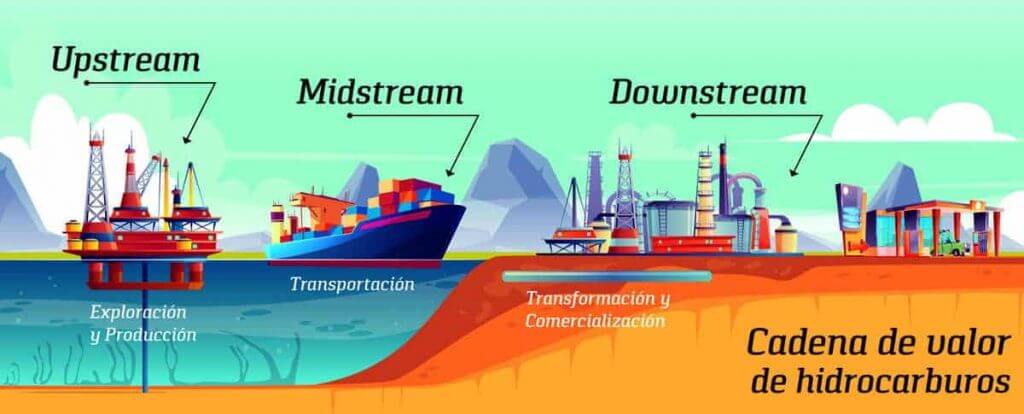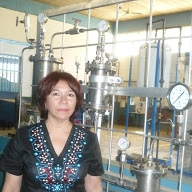The oil and gas industry encompasses the comprehensive processes of exploration, extraction, refining, transportation (by oil tankers and pipelines) and the marketing of oil products. The largest volume of products in the industry are fuel oil and gasoline. Oil is also the raw material for many chemicals, including pharmaceuticals, solvents. This industry creates a set of challenges for owners and operators. As stocks dwindle and product demand fluctuates, services seeking efficiency, accuracy and reliability within the industry are becoming increasingly important.
Oil is vital to many industries, and is of great importance in maintaining the industrial sector in its current configuration, and is therefore a critical concern for many nations. Oil accounts for a large percentage of global energy consumption, ranging from a low of 32% for Europe and Asia to a high of 53% for the Middle East. Oil can be found on land and offshore (Onshore and Offshore).
Hydrocarbon value chain
The value links that correspond to the set of economic and administrative activities of the oil industry related to: Exploration, exploitation/production, conditioning and basic distribution; which are made up of the regulation and administration of these activities. In this article, the integral stages of the oil and gas sector will be exposed from the administrative point of view: upstream, midstream and downstream. The figure shows a representative image of these stages.
- Upstream: (upstream). Provider Stage, involves the exploration and production processes
- Midstream: (The middle of the stream). Transport and commercialization of hydrocarbons,
- Downstream: (downstream). Transformation stage, corresponds to the refining, processing, and marketing of derivatives.

Upstream
The upstream oil sector is also commonly known as the exploration and production sector. The upstream sector includes searching for potential underground or subsea crude oil and natural gas fields, drilling exploratory wells, and subsequently drilling and operating the wells that recover and bring the crude oil and/or raw natural gas to the surface. . There has been a significant shift towards including unconventional gas as part of the upstream sector [1].
Oil drilling is the process by which usable oil is extracted and removed from the ground. Geologists use seismic surveys to look for geological structures that may form oil reservoirs. The classic method involves blasting nearby underground and observing the seismic response which provides information about the geological structures below ground. However, “passive” methods that extract information from natural seismic waves are also known.
Basic operations involved in the upstream
Exploration: It is a basic activity to obtain the first indications of a potential deposit in the subsoil. To carry out this activity there are a wide number of geophysical exploration methods such as seismic, magnetometry, gravimetry, etc.
The objective of this process is to obtain a representative image of the rock layers that exist in the subsoil. [two]
The process continues with the drilling of wells, the purpose of which is to reach the objective where it has been foreseen that there is possibly an accumulation of hydrocarbons (oil and gas).
In summary, in this stage the information of the corresponding exploration geophysical study is obtained. And it continues with the discovery of a producing well.
Exploitation: It is the process by which hydrocarbons (oil and gas) are extracted, using the energy of the reservoir itself or some mechanical system externally.
The objective of this activity is to drill and produce wells in a reasoned and efficient manner to transport fluids from the producing interval in the subsoil to the surface.
Intermediate Stream (Midstream)
Broadly speaking, the midstream (the middle of the current) is also known as the transportation stage, whether by pipeline, rail, ship, tanker, or truck, it also includes the storage and wholesale marketing of crude products. of oil. [3]
Midstream operations are sometimes classified within the downstream sector, but these operations make up a separate and discrete sector of the petroleum industry.
Basic operations involved in the midstream.
The midstream provides the vital link between oil-producing areas and the consumer.
Storage and Transportation and Marketing: Consists of the action of storage and/or transportation of hydrocarbon fluids (oil and gas) from the point of sale to the appropriate storage and processing sites; such as pumping stations, refineries and marketing centers (ports). Hydrocarbons are transported through pipelines (petroleum), gas pipelines (gas), tank cars (petroleum) and ships (petroleum), etc. [1, 2].
Downstream
The downstream sector commonly refers to the refining of crude oil and the processing and purification of raw natural gas, as well as the marketing and distribution of products derived from crude oil and natural gas [1]. The downstream sector corresponds to consumers through products such as gasoline, kerosene, jet fuel, diesel oil, heating oil, fuel oils, lubricants, waxes, asphalt and natural gas such as hundreds of petrochemicals.
An oil refinery is an industrial processing plant where crude oil is processed and refined into more useful products such as petroleum naphtha, gasoline, diesel and asphalt base, heating oil, kerosene and liquefied petroleum gas. Petroleum. Oil refineries are typically large, sprawling industrial complexes with extensive pipelines that carry fluid flows between large chemical processing units.
Basic operations involved in the Downstream
Processing and Refining: Processing and refining consists of transforming oil by subjecting it to high temperatures, reaching 400 degrees Celsius, to obtain derivative products. Process by which crude oil is transformed into a wide variety of derived products, mainly fuels (diesel, gasoline, etc.) and petrochemicals related to manufacturing (vaseline, brushes, tires, plastics, etc.). [1,2]
Marketing of derivatives: In this link, all those activities of a commercial nature are carried out, to place the derivative products at the disposal of users.
Conclusion
The three stages of the oil industry such as Upstream, Midstream and Downstream, are worldwide stages of any oil company, in which a risk is faced on all fronts such as environmental, geological, economic, political, etc
References
[1] PSG, Company, “Defining Upstream Oil & Gas”, USA, web portal: http://www.psgdover.com/es/oil-and-gas/oil-gas-market-overview/oil-gas- upstream
[2] Regionalization Program, hydrocarbon sector, Colombia., web portal:
http://www.anh.gov.co/portalregionalizacion/Paginas/ .
[3] Petroleum Services Association of Canada, (PSAC), “Industry Overview”,
http://www.psac.ca/business/industry-overview/”, World Petroleum Council
Canada, “About the industry” Portal, http: //wpccanada.com/yc/industry-info/aboutthe-
industry/upstream-midstream-downstream.html.
About the Author
Ph.D, in Electrochemistry and Corrosion, with more than 30 years of experience and a wide and versatile knowledge in Corrosion Sciences and Chemical Technology at the Academic and Industrial level. Researcher in the development of research work on Innovation and development of Electroactive Polymeric Coatings, evaluation of coatings and corrosion inhibitors and failure analysis of metallic materials. Advisor of plans of maintenance programs in the industry in oil companies, in front of works of chemical and mechanical cleaning services of equipment such as: Boilers, Heat exchangers, among others.
Read more


